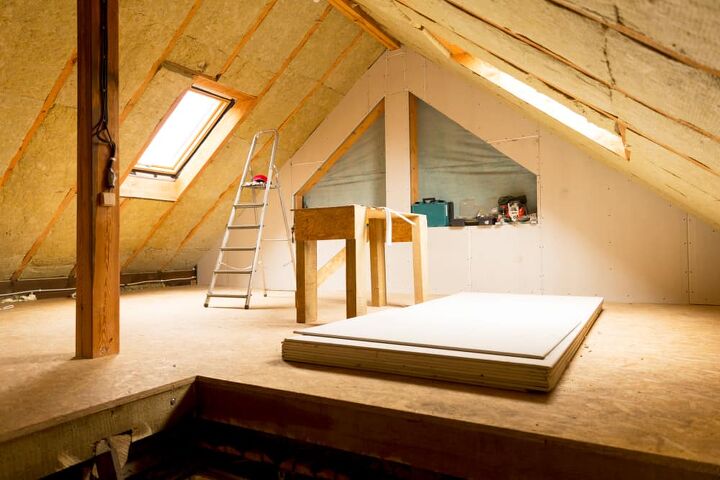How To Keep Insulation From Falling Down (Do This!)

All that insulation you put in your attic will not do you much good if it falls down. It has to be snug between rafters to stay in place and it is best to have something to hold it in place. After all, you cannot have your insulation laying on the floor. It will not do you much good down there.
Use metal installation hangars or nylon straps to keep your insulation from falling down. You can buy these at your local hardware store, big-box store, or make them with your own wire. Just make sure the wire is galvanized with pointed ends to get them to stay in between the joists.
When you get insulation put in or put it in yourself, you do not expect it to fall right back down. The insulation should be cut to fit perfectly between the joists. They cannot be bunched up or flattened because the insulating factor depends on the thickness and compressing it will lower the R-value. Here are some of the ways you can keep your insulation from falling down.
Do You Need Insulation Installers?
Get free, zero-commitment quotes from pro contractors near you.

Using Metal Installation Hangars to Keep Insulation from Falling Down
The metal installation hangars are available in different sizes and can be found at most big box stores or a hardware store. The ends of the hangars are pointed to hold them into place between floor joists. Each box of 100 pieces will cover 150 square feet.
1. Put on Your Personal Protective Equipment
This should include safety goggles or glasses with side shields to keep the insulation particles out of your eyes. In addition, earplugs or earmuffs would be good to keep it out of your ears. Leather or cotton work gloves, a hat, long sleeves, and long pants need to be worn to protect your skin. And finally, wear a mask with a respirator or N95 mask to protect your lungs.
2. Check Your Insulation for Moisture
Before fixing the fallen insulation, you need to check it to see if it is wet. If it is, there is a good chance there is or will be mildew or mold growing in it. If that is the case, you need to replace that part of your insulation.
3. Place Your Metal Installation Hangars
The metal installation hangars come in different sizes from 12 inches to 24 inches and will typically be in a batch of 100. You will need to use one every 12 to 16 inches. Just place the wire in between the floor joists and push up in the middle. It should stay where you put it.
How to Keep Insulation from Falling Down with Nylon Straps
Nylon straps work especially well for those who have multiple sized gaps in between your joists. Rather than have to buy multiple sets of metal installation hangars, if you get nylon straps, you can cut them to the sizes you need. You can get this online, from a hardware store, or a big box store.
1. Protect Yourself First
You should always put on protective clothing and other PPE before doing anything with insulation. It is best to wear a long-sleeved shirt, long pants, a hat, glasses that have side shields, gloves, and a mask that is rated N95 or above. You should also wear earmuffs or earplugs to protect your ears.
2. Look Carefully at Your Insulation
You will need to make sure the insulation is not damaged by moisture. If you see that it has gotten wet, if it still feels moist, or if there are black spots on it, you will need to put up new insulation before putting the nylon straps up to keep it in place.
3. Cut and Place the Nylon Straps
Measure between the joists where the insulation has fallen so you know how much to cut off. The nylon comes in a big roll like tape that has holes in it for nails or staples. Cut strips to the sizes you need and secure them to the joists to keep the insulation from coming back down. It is best to place the straps every 12 to 16 inches.
Using Netting to Keep Insulation from Falling Down
You can use special netting made just for insulation that they sell at the store or online. They come in many different sizes and widths from 12 to 24 inches and the rolls typically hold about 125 to 500 feet or more. This is a nice cheap option since they come in such huge rolls.
1. Wear Your Gloves and Goggles
Before starting this project, get some good work gloves and some goggles that have side protection. You will also need to wear ear protection and a hat, long pants and a shirt with long sleeves, as well as sturdy shoes. Your mask should be at least N95 or higher to protect your lungs.
2. Make Sure Your Insulation is Not Moldy
There is obviously a reason why your insulation is falling down. It could be that it is heavy from getting wet. If that is the case, you will need to replace that part of the insulation because mold or mildew is likely to be involved, and you do not want that.
3. Cut the Rolls into Shape
Since the netting is sold in rolls, you can measure and cut it into sheets of the sizes you need. Then just use nails or staples to tack it to the joists. Because it is so wide, you do not have to place them close together. As long as the spaces in between are not larger than 16 inches wide.
Keeping Insulation from Falling Down with Chicken Wire
Chicken wire is a fantastic way to keep your insulation in place without blocking it from getting air. Not only is it efficient, but it is also very inexpensive. And you can get it just about anywhere in a multitude of sizes.
1. Make Sure You Are Covered
Insulation can irritate your skin, so you need to wear long sleeves, long pants, a hat, and gloves. You will also need to protect your eyes with glasses or goggles that have side protection on them and get some earmuffs or earplugs for your ears. Do not forget your lungs. Use a mask with a protection level of N95 or higher.
2. Take a Good Look at Your Insulation
Check out the insulation that fell. There has to be a reason that it fell so make sure it wasn’t because it got wet. If the insulation is wet, you will need to get rid of it and replace it before fixing it back up there. Wet insulation will lead to mildew or mold, which is dangerous.
3. Measure and Hang the Chicken Wire
Using chicken wire, you can take the roll and cover the whole area. Just be sure to use a staple gun to secure it to each joist in between. The wire should stay in place and you will not have to use as much of it since it is so wide.
Do You Need Insulation Installers?
Get free, zero-commitment quotes from pro contractors near you.

Related Questions
What if I do find mold?
If you have mold in any of your insulation, you will need to check all of it to be sure that there is no more. And figure out where the moisture is coming from. Do you have a leak somewhere? Or it may be that your insulation was not ventilated properly. If so, that will need to be fixed before replacing the insulation. Then you can secure it with one of the ideas above.
How Do I Know if My Crawl Space is Ventilated?
There are several clues that will let you know if your crawl space is ventilated. If you notice condensation on the surfaces of anything inside the crawl space. If the insulation is wet and sagging. You may see mold or smell a moldy and musty smell. The wood may be rotting. Your floors above the crawl space are cold. Or your heating bill may be unusually high. These are all clues that your crawl space is not properly ventilated.
Which Way Should My Insulation Be Facing?
No matter where your insulation is located, the paper is supposed to be facing toward the inside of your home. The paper part has a layer of asphalt that prevents water vapor from passing through it. Similarly, if you use faced batting, the moisture barrier should face toward your attic.
Related Guides

I am a DIYer who loves writing about anything home-related. When I am not writing, you can find me studying for my PhD in Psychology, photographing nature, and swimming at the lake with my grandkids.
More by Patricia Oelze










![10 Best Cordless Leaf Blowers – [2022 Reviews & Ultimate Guide]](https://cdn-fastly.upgradedhome.com/media/2023/07/31/9070789/10-best-cordless-leaf-blowers-2022-reviews-ultimate-guide.jpg?size=350x220)








![10 Most Dangerous Neighborhoods in Baltimore [Updated]](https://cdn-fastly.upgradedhome.com/media/2023/07/31/9075655/10-most-dangerous-neighborhoods-in-baltimore-updated.jpg?size=350x220)







